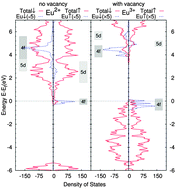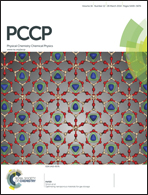The role of the Ca vacancy in the determination of the europium position in the energy gap, its valence state and spectroscopic properties in KCa(PO3)3†
Abstract
A new very promising red phosphor KCa1−xEux(PO3)3 (x = 1–5%) has been grown by the solid state method. Its luminescent quantum efficiency is close to 100% and the emission is stable over a wide temperature range i.e. 90% and 60% of the room temperature emission intensity remains at 200 °C and at 600 °C, respectively. The chromaticity coordinates were calculated as being x = 0.63, y = 0.37. The IR and Raman spectra were measured, and the maximum phonon energy of KCa1−xEux(PO3)3 is 1276 cm−1. In the measured emission and excitation spectra of all samples only Eu3+ ion emission was observed, emission of Eu2+ is not present. Quantum mechanical calculations showed that in a perfect crystal the 5d levels of Eu2+ are embedded in the conduction band. Consequently, neither absorption nor emission assigned to the Eu2+ ions could be observed. The presence of a calcium vacancy is crucial for the explanation of the observed spectrum. The existence of a Ca2+ vacancy compensates for the charge of Eu3+ and results in the creation of the magnetic moment which moves the 4f levels to the valence band. Thus, transitions to the Eu3+ excited levels located in the energy band gap are observed.


 Please wait while we load your content...
Please wait while we load your content...